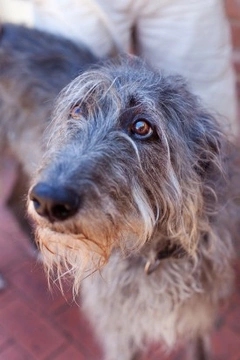
Deerhound hereditary health and genetic diversity
The deerhound is a large breed of dog that hails from Scotland, and which falls within the sighthound type grouping. In terms of their shape and build, they resemble the greyhound, although the deerhound is much taller, slightly heavier, and has a different type of coat.
The deerhound is classed as a large dog breed and one of the tallest sighthounds, standing up to 32” tall at the withers, possibly more for males, and weighing between 40-50kg. They have a harsh, rough coat that is relatively long, with softer fur on their face, belly and chest, and are grey or blue-grey in colour.
While the deerhound was historically used as a hunting dog to help to catch game, as hunting has become less and less popular within the UK, today they are most widely owned as pets. While not as popular as some other sighthound breeds such as the greyhound and whippet, the deerhound is a loving, gentle large breed that is well worth considering.
If you are wondering if the deerhound is the right choice of pet for you, in this article we will look at their longevity, hereditary health and genetic diversity in more detail. Read on to learn more.
Deerhound longevity
The average lifespan of the deerhound is 8-9 years, which places them fairly low in the rankings for dogs of a similar size of all breeds. While large and giant breeds of dog do tend to have shorter lifespans than their smaller counterparts, certain hereditary factors within the deerhound breed do, in some breed lines, contribute to a shorter lifespan than would otherwise be expected.
Genetic diversity within the deerhound breed
The coefficient of inbreeding statistic for the deerhound is 12.7%, which is significantly higher than the 6.25% or lower that is considered to be the ideal. This means that the deerhound breed as a whole is prone to a reasonable degree of inbreeding in order to keep the breed viable, and this in its turn can help to strengthen the presence of some hereditary health defects and undesirable traits within the breed.
Breeders of the deerhound are advised to keep the coefficient of inbreeding statistic as low as possible within their own breed lines, and work to reduce the figure with each subsequent generation that they breed.
Health testing for the deerhound
In order to help to eradicate the prevalence of hereditary health defects across the breed as a whole, breeders of the deerhound are advised to undertake certain tests and screening processes on their dogs prior to breeding or sale.
DNA testing is available for potential parent dogs, to identify a deficiency in Factor V11, which causes a mild bleeding disease within affected dogs.
Litters of deerhound pups should also be screened for the potential for liver shunt prior to being sold.
Conformation issues within the breed
The tall, long legged and deep chested build of the breed means that the deerhound is one breed that is considered to have elevated risk factors for bloat, or gastric torsion. This condition is most commonly seen in large dogs with deep and yet narrow chests, such as the deerhound.
Bloat or gastric torsion is an acute condition that causes the stomach to fill with gas, and potentially flip over on itself. The condition can develop with no prior warning, and requires urgent veterinary treatment in order to avoid proving fatal.
Other health issues across the breed as a whole
The deerhound breed has also been identified to have a predisposition to certain other health issues and hereditary problems too, but for which there are currently no health tests or screening schemes available. These can include:
- Osteosarcoma, or cancer of the bones.
- Urolithiasis, which is the formation of crystals and stones within the urine, which can cause blockages as well as being painful to pass. Sometimes, surgical intervention is required to remove larger stones.
- Various different cardiac conditions, which can cause heart disease, may also be present within the breed. The most widely diagnosed of these is dilated cardiomyopathy, which is a degeneration of the muscles of the heart.
- A degenerative condition that affects the neck bones, called arthrosis of the cervical articular facet joints, is also seen within some deerhound breed lines.
- A congenital version of portosystemic shunt, which causes the circulatory system to bypass the liver, can be found within the breed. This leads to a dangerous build-up of toxins within the blood stream, as they are not eliminated in the normal manner.
While it is not possible to definitively ascertain a propensity to any of these conditions prior to making a purchase, finding out about the lifelong health of the parents and grandparents of any given dog can help to identify a future likelihood of health problems. When buying a puppy, this information should be made available to you upon request by the breeder.



